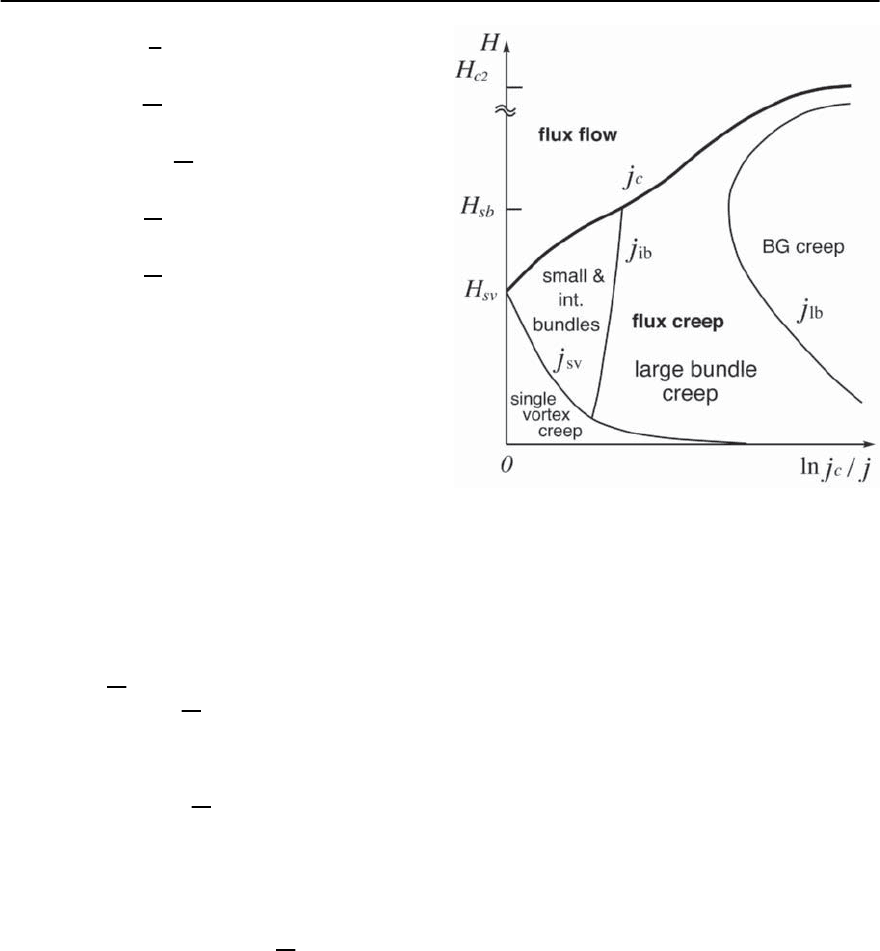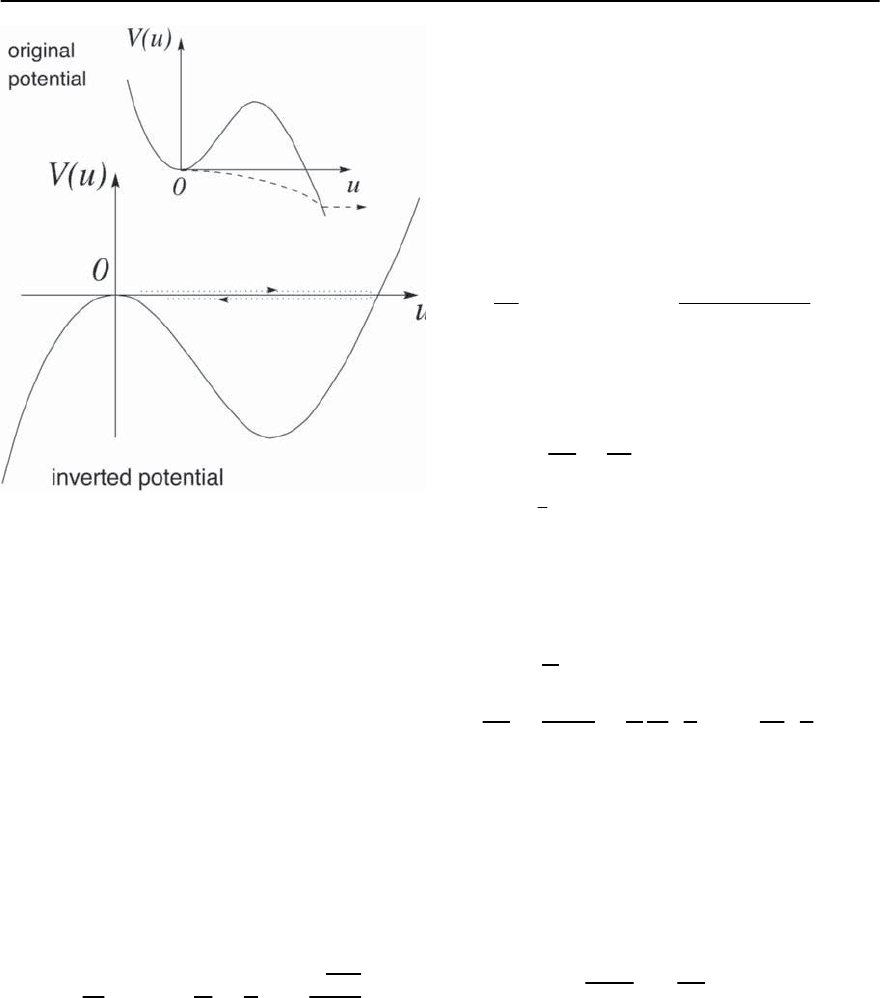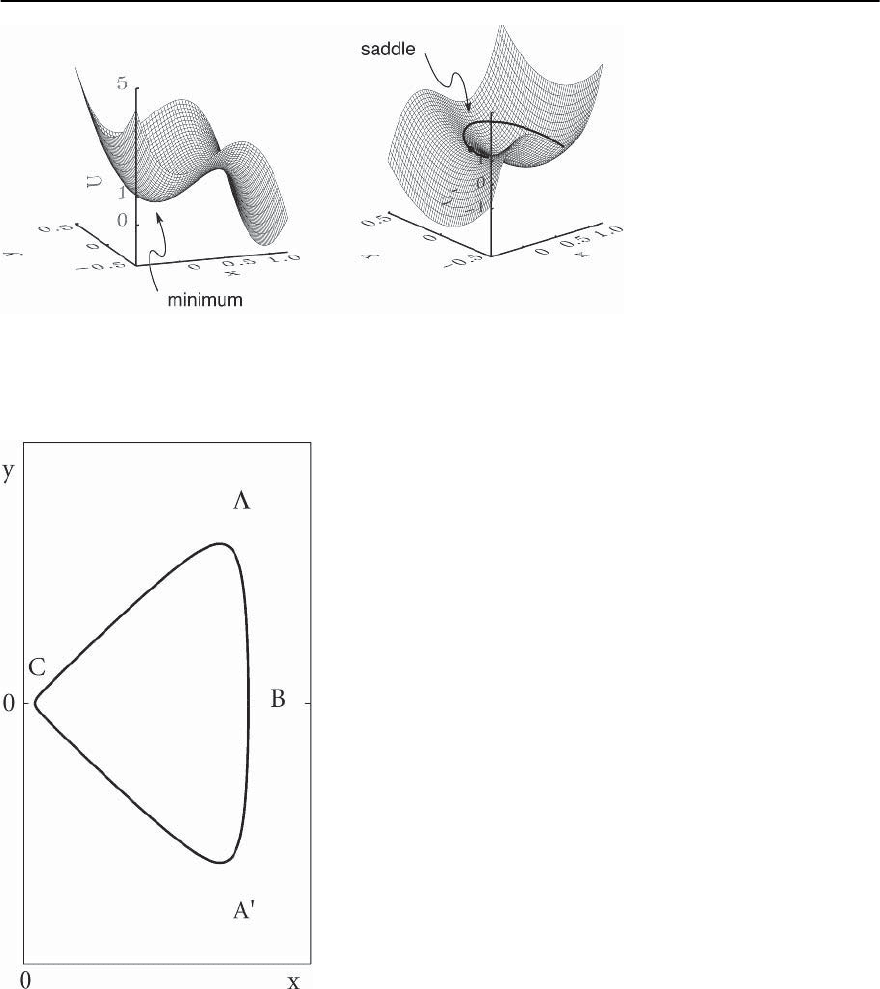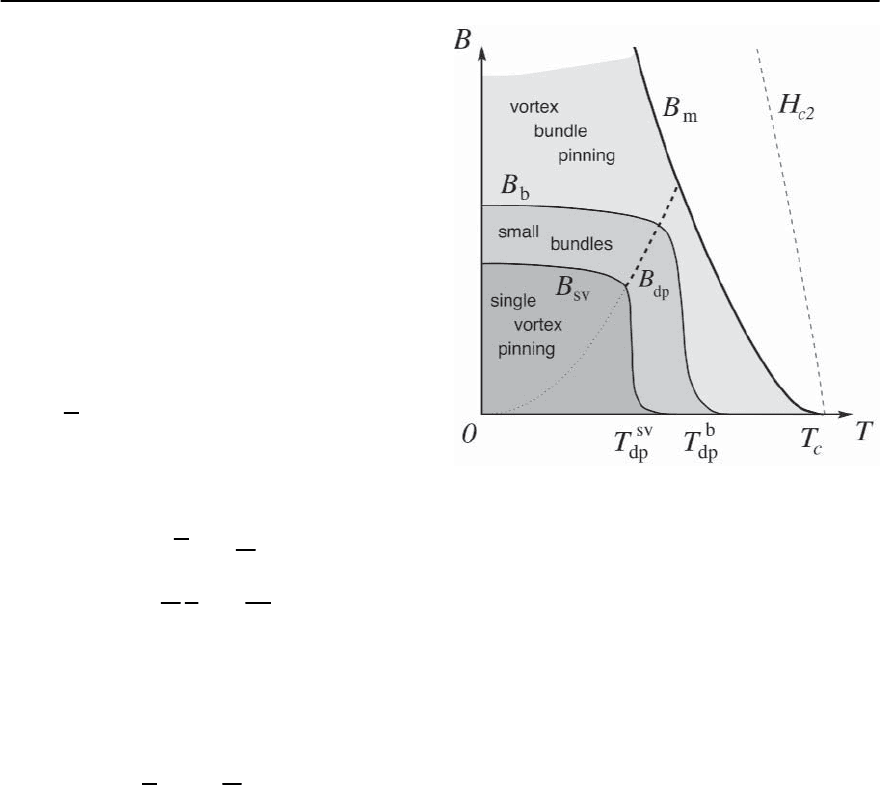Bennemann K.H., Ketterson J.B. Superconductivity: Volume 1: Conventional and Unconventional Superconductors; Volume 2: Novel Superconductors
Подождите немного. Документ загружается.


590 G. Blatter and V.B. Geshkenbein
L
opt
(F) ∼ L
c
F
c
F
1/(2−
d,n
)
,
u
opt
(F) ∼
F
c
F
d,n
/(2−
d,n
)
. (12.373)
Inserting the result for L
opt
(F) back into (12.372) we
obtain the creep barrier with its characteristic glassy
exponent ,
U(F)=U
c
F
c
F
, =
2
d,n
+ d −2
2−
d,n
. (12.374)
When applying this general resultto the vortex lat-
tice we have to account for the modifications due to
the dispersive nature of the elastic moduli and the
anisotropic geometry of the superbundles. Within
the small bundle pinning regime, the bundle dimen-
sions along the field as well as along the direction
of the hop grow very fast, L
b
∼ R
∼ R
3
⊥
/a
2
0
.Us-
ing the scaling behavior of R
⊥
with current density
j, R
⊥
(j) ∝ (j
c
/j)
1/(2−)
(this relation follows from bal-
ancing the elastic (shear) energy against the energy
gain from the driving Lorentz force), we obtain the
scaling laws L
b
∼ R
∝ (j
c
/j)
3/(2−)
for the bundle
dimensions in the field/forceplane.For intermediate
size bundles we have L
b
∼ R
∼ (R
3
⊥
/a
2
0
)
1/2
and
hence L
b
∼ R
∝ (j
c
/j)
3/2(2−)
. Finally,for large bun-
dles, L
b
∼ R
∼ (/a
0
)R
⊥
and no additional scaling
factors arise. Summarizing, we have to modify the
result (12.374) within the small (and intermediate)
bundle pinning regime by changing the exponent
(the correction terms follow from the additional ge-
ometry factor L
b
R
/R
2
⊥
, cf. (12.368)),
→ +
4
2−
, small bundles (12.375)
→ +
1
2−
, intermediate bundles .
A further complication concerns the wandering ex-
ponent : Within the small bundle pinning regime,
the generalized Larkin–Ovchinnikov result (12.371)
for the displacement correlation function u
2
(R, L)
depends only logarithmically on the distances R and
L and hence the wandering exponent changes to
the new value = 0 within the small bundle creep
regime. This reduced exponent remains also valid
within the intermediate bundle creep regime where
the transverse length R
⊥
due to the shear relaxation
in the subbundles is still smaller than the screening
length . We then arrive at the following exponents
characterizing creep of vortex bundles within the
lattice pinning regime:
=
5
2
, small bundles ,
a
0
< R
⊥
, R
∼ L
b
< ,
=1, intermediate bundles ,
a
0
< R
⊥
< < R
∼ L
b
,
≈
7
9
, large bundles , < R
⊥
, R
∼ L
b
.
(12.376)
The above results are applicable within the random
manifold pinning regime where the typical hopping
distance u is less than the lattice constant a
0
of the
flux line lattice. On the other hand, the relevant hop-
ping distance u can grow well beyond this value, e.g.,
by decreasing the current density j or in the context
of relaxation on large scales, implying a crossover
to the Bragg-glass (BG) scaling regime. Within this
regime, the wandering exponent is again reduced
to zero and the exponent takes the value
=
1
2
, BG regime , R
a
< R
⊥
. (12.377)
In calculating the above creep exponents we have
assumed wandering exponents = 0 (small bun-
dles), = 0 (intermediate bundles), ≈ 1/5(large
bundles), and = 0 in the BG creep regime.
We now are ready to collect the results describ-
ing creep at small driving forces j j
c
.Letusas-
sume that the sample has been initially prepared in
a critical state belonging to the single vortex pin-
ning regime, i.e., L
c
< a
0
(note that we use the line
wandering exponent
SR
1,2
=3/5 rather than the re-
sult
1,2
≈ 5/8 derived from numerical simulations
and used in Sect. 12.9.4 above). As the current j de-
cays due to creep, the activation barrier U(j )evolves
according to the following scheme:

12 Vortex Matter 591
U(j) ≈
⎧
⎪
⎪
⎪
⎪
⎪
⎪
⎪
⎪
⎪
⎪
⎪
⎪
⎪
⎪
⎪
⎪
⎪
⎨
⎪
⎪
⎪
⎪
⎪
⎪
⎪
⎪
⎪
⎪
⎪
⎪
⎪
⎪
⎪
⎪
⎪
⎩
U
c
j
c
j
1/7
, j
sv
< j j
c
,
U
sb
j
sv
j
5/2
, j
sb
< j < j
sv
,
U
ib
j
sb
j
, j
ib
< j < j
sb
,
U
lb
j
ib
j
7/9
, j
lb
< j < j
ib
,
U
BG
j
lb
j
1/2
, 0 < j < j
lb
,
(12.378)
with U
sb
≈ U
c
(a
0
/L
c
)
1/5
, U
ib
≈ U
sb
(/a
0
)
5/3
,
U
lb
≈ U
ib
(/a
0
)
4/3
, U
BG
≈ U
lb
(a
2
0
L
3
c
/
5
)
7/5
; j
sv
≈
j
c
(L
c
/a
0
)
7/5
, j
sb
≈ j
sv
(a
0
/)
2/3
, j
ib
≈ j
sb
(a
0
/)
4/3
,
j
lb
≈ j
ib
(
5
/a
2
0
L
3
c
)
9/5
. The time decay of the current
density followstriviallyfromcombining (12.302)and
(12.378) and solving for j. The various creep regimes
are illustrated in Fig. 12.28.
Again we adda note on anisotropic materials mak-
ing use of our scaling rules (12.170); basically, the
scaling approach is limited to length scales R
< ,
however, one can show [150] that the results can be
extended to the larger regime R
< /".Weas-
sume a current density j directed along the planes,
j ⊥ H and have the vortex system start decaying
from the single vortex pinning regime such that
L
c
c
< "a
0
/
√
"
#
. As the current density j drops be-
low j
sv
(# , B) ≈ j
c
c
(
√
"
#
L
c
c
/"a
0
)
7/5
(for
1,2
≈ 5/8
the exponent is 11/8), we enter the vortex bundle
creep regime where the activation barrier increases
rapidly, U(# , j, B) ≈ U
sb
(# , B)[j
sv
(# , B)/j]
5/2
,with
U
sb
(# , B) ≈ U
c
c
("a
0
/
√
"
#
L
c
c
)
1/5
,obtainedbyrequir-
ing continuity across the boundary between the
single vortex and the lattice pinning regimes. The
boundary j
sc
(# , B), within which the scaling the-
ory can be applied, is found by rescaling the con-
dition R
(j
sc
) ≈ a
0
(j
sb
/j
sc
)
3/2
∼ /",andweob-
tain j
sc
(# , B) ∼ j
sv
(# , B)("a
0
/
√
"
#
)
2/3
.Notethat
j
sc
is larger than the current density j
ib
limiting the
small/intermediatebundlepinning regime.Fora cur-
rent density j directed along the y
axis (out-of-plane
current) the creep motion is directed along the su-
perconducting planes and we have to substitute the
in-plane current density ratio j
sv
/j by its out-of-
plane counterpart "
#
j
sv
/j. The extension of the creep
Fig. 12.28. Creep regimes and their relative position within
the B–j plane. Disorder is irrelevant in the flux-flow regime
at large fields and large current densities.Vortices move via
creep in the low-field-low-current region below the criti-
cal current density j
c
(B). The flux creep regime is divided
up into a single-vortex creep regime at large current densi-
ties,followed by the small to intermediate and large bundle
creep regimes at lower current densities (larger fields). At
very low current densities we enter the BG creep regime
analysis to anisotropic materials beyond the scaling
regime is rather tedious and we refer the reader to
the original literature [150].
Quantum Creep
Abovewehaveanalyzedthedecayofavortexden-
sity gradient due to thermal activation of the vor-
tices out of their metastable states. According to this
classical picture the decay rate (12.365) should van-
ish in the zero temperature limit. However, one may
expect that quantum fluctuations trigger a decay
of the critical state via quantum tunneling at low
temperatures, leading to a saturation of the decay
rate S =dlnj /dlnt. Indeed, such a saturation has
been observed in a number of experiments on oxide
superconductors [50, 52, 388], as well as in Chevrel

592 G. Blatter and V.B. Geshkenbein
phase [389], organic[390] and heavy fermion super-
conductors [391].
Macroscopic quantum phenomena have always at-
tracted much interest as they naturally touch the
boundary between quantum and classical physics:
macroscopic systems are coupled to their environ-
ment and thus are inherently dissipative. The clas-
sic and most carefully studied system exhibiting
macroscopic quantum tunneling is the (rf) super-
conducting quantum interference device (SQUID)
[149, 392–395]. In particular, Caldeira and Leggett
[149] have discussed in detail how to extend the
quantum description to macroscopic systems, the
main effect of the dissipative environment being to
suppress the probability for the tunneling process.
Later, this early work has been extended to vortex
motion by quantum tunneling in Josephson junction
arrays [396], thin (disordered) films [397–399], and
bulk superconductors[400,401].
The decay of a metastable state due to tunneling
is similar to the classical decay process via thermal
activation; the additional feature to be taken care of
in a tunneling process is the time component of the
motion. During tunneling the vortex moves under
the barrier, hence the process is forbidden (virtual)
and the longer the time the string spends under the
barrier, the less chances there are for the process to
happen (for the thermally activated situation time is
irrelevant as the vortex hops over the energy barrier
in a real process). While for an activated motion the
probability is determined by the saddle-point solu-
tion of the free energy (12.313), one has to find the
saddle-point solution of the Euclidean action in or-
der to describe a tunneling event [149,402–406]. The
quantum problem then is a d +1-dimensionalgen-
eralization of the d-dimensional classical problem,
where d denotes again the dimension of the object,
e.g., d = 1 for the vortex line.
As discussed in Sect.12.3.2 above,the vortex equa-
tion of motion involves transverse (Hall) and dissi-
pative forces, see (12.45),
m
l
˙v
L
+
l
v
L
+ ˛
l
v
L
∧ˆz = f
ext
. (12.379)
Here, we include an additional massive term m
l
˙v
L
with the motivation that the quantum tunneling of
a massive object is the most simple case to analyze.
Expanding the dynamical coefficients in (12.45) it is
possible to derive a vortex mass (see also [407,408],
where an electronic vortex mass m
el
≈ (2/
3
)m
e
k
F
has been found, and [409,410] reporting a mass en-
hanced by a factor (k
F
)
2
in a superclean material;
besides the electronic contribution, a second term
m
em
=(¥
0
/4c)
2
of electromagnetic origin con-
tributesto the vortex mass [407];in a tunnel junction
this result is modified to m
em
∼ C¥
2
0
/
pc
c
2
with C
the junctioncapacitance and
pc
the size of the phase
core, typically m
el
m
em
), however,it turns out that
in a bulk superconductor the dissipative and Hall
termsalwaysdominateoverthemassterm,thedis-
sipative contribution being the most relevant one in
dirty and clean materials while the Hall term domi-
nates in the superclean limit.In the following,we first
discuss the simple and illustrative case of tunneling
of a massive string and then proceed with the analy-
sis of vortex tunneling,discussing the dissipative and
Hall tunneling in sequence.
The Lagrangian generating the classical equation
of motion for a massive elastic string is
L
u
=
dz
m
l
2
(@
t
u)
2
− F
u
, (12.380)
with the free energy functional F[u]givenby
(12.313). The displacement vector u(z, t)playsthe
role of the macroscopic variable.
Substituting t → −it in (12.380) we obtain the
(imaginary time) Euclidean action [405,406],
S
E
=
dt
dz
m
l
2
(@
t
u)
2
+ F
u
, (12.381)
for which we have to find the saddle-point solution.
The saddle-point solution is given by the classical
bounce trajectory where the string moves through
the inverted potential and bounces back to the ori-
gin, see Fig. 12.29 for a sketch illustrating the tunnel-
ing trajectory of a particle. Here, we are interested
in the scale for the action, i.e., we wish to determine
the quantity corresponding to U
c
,andthuswesetthe
driving force equal to zero, j = 0. Equation (12.381)
then has to be minimized with respect to the form
(length L and displacement u)andthedurationt of
the bounce and we will do this on the level of scal-
ing estimates. At this point we should note that the

12 Vortex Matter 593
Fig. 12.29. The tunneling trajectory (bounce, dotted line,
massive dynamics) is found as the classical solution of the
equation of motion in the inverted potential. In the dissi-
pative situation energy is transferred from the system to
the reservoir (dashed line)
tunneling process involves the same initial and final
states as encountered above in the determination of
the classical creep rate; the additional new feature
in the quantum problem is the relevance of the time
evolution of the vortex motion. In fact, the determi-
nation of the optimal geometry for the bounce so-
lution involves only the free energy part of (12.381)
and the result in the form of the collective pinning
length L
c
has been found above (12.325); the dis-
placement u ∼ is given by the disorder landscape.
Theestimateforthetunnelingtimet
c
is obtained by
equating the elastic and the kinetic energy densities,
m
l
(/t
c
)
2
∼ "
l
(/L
c
)
2
,
t
c
∼
m
l
"
l
1/2
L
c
,
S
E
∼
t
c
U
c
∼
√
"
l
m
l
2
,
(12.382)
wherewehaveinsertedtheresultt
c
into (12.381) in
order to find the minimal action for the tunneling
process in the last equation.In the limit of vanishing
dissipation the action does not depend on the collec-
tive pinning length L
c
and hence is independent of
the pinning potential.
Let us then apply these ideas to vortex tunnel-
ing. In accounting for the dissipative environment
we restrict ourselves to the simplest case of ohmic
dissipation with the viscous drag coefficient (12.45).
The corresponding dynamical term in the vortex ac-
tion can be obtained by coupling the system to a bath
of harmonic oscillators and subsequent integration
over the environmental (bath) variables [149],
l
4
dt
dt
dz
u(z, t)−u(z, t
)
t − t
2
.
(12.383)
The expression (12.383) is nonlocal in time and we
transform to Fourier space to obtain the effective ac-
tion,
S
eff
E
=
d!
2
dq
2
(12.384)
1
2
l
|!| + "
l
q
2
|u(q, !)|
2
+
pin
(q, u)
.
Equating the dynamical and elastic energy densities,
l
!
c
u
2
∼ "
l
q
2
c
u
2
,withq
c
∼ 1/L
c
the inverse length
of the tunneling segment,we find the tunneling time
t
c
∼ 1/!
c
and the corresponding action,
t
c
∼
l
"
l
L
2
c
, (12.385)
S
eff
E
∼
l
2
L
c
∼
e
2
n
j
0
j
c
1/2
∼
1
Qu
j
0
j
c
1/2
,
with L
c
given by (12.327). Here, we have introduced
the dimensionless parameter Qu =(e
2
/)(
n
/)
quantifying the strength of quantum fluctuations
and playing the role analogousto the Ginzburg num-
ber in the context of thermal fluctuations. For an
anisotropic material we have to substitute L
c
→ L
c
c
and hence S
eff
E
= "
4/3
S
eff,iso
E
.
The normalized creep rate S near j
c
takes the form,
S =
dlnj
dlnt
≈ −
S
eff
E
. (12.386)
The main parameter determining the action and the
tunneling rate is the ratio
n
/.Asmallactionfavor-
ing tunneling is obtained in materials characterized
by a large normal state resistivity
n
and a small co-
herence length . The quantum unit of resistance is

594 G. Blatter and V.B. Geshkenbein
/e
2
≈ 4.1k§, thus the phenomenon of quantum
creep should become experimentally observable for
ratios
n
/ ≥ 1k§.The result (12.386) depends only
weakly on the disorder potential via a square root de-
pendence on the critical current density j
c
.
Finally, let us discuss the case of a Hall-type vor-
tex dynamics as it is relevant in a superclean su-
perconductor (cf. Sect. 12.3.2; the Hall dynamics is
also relevant for the tunneling of vortices in super-
fluid He [411]). Substituting the dissipative dynami-
cal term
l
|!|u
2
by the Hall term ˛
l
!u
2
in the action
for the tunneling process and proceeding with scal-
ing estimates we immediately reproduce the result
(12.386) above but with
l
replaced by ˛
l
,
S
H
E
∼
˛
l
2
L
c
∼ n
3
j
n
j
c
1/2
. (12.387)
However, there is a lot of additional interesting
physics associated with the Hall tunneling of vor-
tices [412, 413]. In particular, the geometry of the
bounce solution is very different from that found in
the massive or in the dissipative situation. In the fol-
lowing, we discuss a model calculation which high-
lights the important differences and which also is
relevant for the tunneling motion of a (collectively)
pinned vortex. We concentrate on the 2D situation,
describing a vortex in a thin film (of thickness d)or
a pancake vortex in a strongly layered superconduc-
tor, see Sect. 12.5.3. Rewriting the external force f
ext
in (12.379) in terms of a potential U (R)theequation
of motion reads
˛
d
v
L
∧ˆz =−∇U(R) , (12.388)
with ˛
d
= ˛
l
d = ¥
0
nd/c (see (12.45)). Equation
(12.388) is the equation of motion of a charged
(e) particle with zero mass in a magnetic field
B =(0, 0, ˛
d
c/e). Such a particle always follows
the equipotential lines defined by the potential U,
v = ∇U ∧ˆz/˛
d
. Expressing (12.388) in components
we obtain the set of equations
˛
d
dx
dt
=
@U (x, y)
@y
, ˛
d
dy
dt
=−
@U (x, y)
@x
.
(12.389)
The action producing these equations of motion is
S
H
=
dt
˛
d
y˙x − U (x, y)
, (12.390)
where the first term is just the Lagrangian j · A/c
of a charged particle moving in a magnetic field B
produced by the vector potential A =(By, 0, 0). The
set of dynamical equations (12.389) is of the Hamil-
tonian form (see also [411,414] where the same ap-
proach has been used in the calculation of vortex tun-
neling in a superfluid and for particle tunneling in
the presence of a strong magnetic field): if we define
the coordinateq =
√
˛
d
x,the momentum p =
√
˛
d
y,
and the Hamiltonian H(q, p)=U(x, y)wefindthat
the set (12.389) is equivalent to the canonical equa-
tions
dq
dt
=
@H(q, p)
@p
,
dp
dt
=−
@H(q, p)
@q
. (12.391)
The Hamilton equations (12.391) describe a parti-
cle moving in one dimension with a dynamics de-
fined by the y dependence of the potential U(x, y).
The coordinates x and y play the role of canonical
variables and we can immediately quantize the the-
ory by imposing the commutation relation [x, y]=
(1/˛
d
)[q, p]=i/˛
d
=i/nd.
An alternative way to go over to a quantum de-
scription starts from the action (12.390): In order
to describe the tunneling motion of the vortex we
have to go over to an imaginary time formalism.
However, a mere substitution t → −it in (12.390)
as done previously leads us to an action describing
aparticlemovinginanimaginarymagneticfield
(only one time derivative appears in the dynamical
part of (12.390)). On the other hand, if we perform
a simultaneous rotation of both the time t and the
y-axis, t → −it and y → iy,thedynamicaltermin
(12.390) becomes real again;in addition,ifthe poten-
tial U (x, y)iseveninthecoordinatey we recover a
real Lagrangian. Finding a saddle-point of the orig-
inal action describing the decay of the metastable
state then becomes equivalent to solving a real clas-
sical problem. In fact, this scheme for obtaining the
desired saddle-point solution can be put on more
firm grounds by exploiting the equivalence between
the original 2D Hall problem and the 1D Hamilto-
nian problem: we assume that the original poten-
tial U(x, y) can be rewritten in a form U(x, y)=
(f /2)y
2
+U
x
(x),then the resulting 1D-problem is that

12 Vortex Matter 595
of a massive particle (with mass m = ˛
d
/f )moving
in a potential U
x
(q/
√
˛
d
) ≡ U
1
(q) (note that close
to a (local) minimum we can expand any potential
U(x, y) into this form if we choose the appropriate
axes). Writing down the action for the 1D-particle
problem and going over to the imaginary time for-
malism we obtain the Euclidean action (t → −it)
S
E
=−iS(t → −it)=
dt
1
2m
˙q
2
+ U
1
(q)
=
dt
p ˙q − H
E
(q, p)
, (12.392)
with the definitionH
E
(q, p)=p
2
/2m − U
1
.The usual
Wick rotation within the Lagrangian formalism is
equivalent to the combined rotation t → −it and
p → ip in the Hamiltonian formalism as the substi-
tution t → −it implies p → ip ; equivalently, we can
invert the potential U
1
(q) → −U
1
(q).
Returning to the original Hall-tunneling problem
in 2D we can set up the appropriate rule to go from
the action (12.390) to the imaginary time expression
S
H
E
.Remembering that the y coordinate plays the role
of the momentum p in the 1D Hamiltonian problem
we obtain the Euclidean action(assuming a potential
U(x, y)=(f /2)y
2
+ U
x
(x))
S
H
E
=−iS(t → −it, y → iy)
=
dt
˛
d
y ˙x −
f
2
y
2
+ U
x
(x)
. (12.393)
According to the above rule we should only invert
the potential along the x-axis, U
x
→ −U
x
;thispar-
tial inversion is crucial forobtaining the appropriate
“bounce”solution for the tunneling action.
ApotentialU(x, y) describing a tunneling situ-
ation should exhibit a local minimum (say at the
origin) and a connection via a saddle to free space
along one direction (the x-axis); we choose the form
U(x, y)=U
c
[y
2
/
2
+ x
2
/
2
− x
3
/
3
] with the pa-
rameters U
c
and describing a weak pinning sit-
uation, cf. Fig. 12.30. The Hall-tunneling problem
maps to the 1D-particle problem with a particle
mass m = ˛
d
2
/2U
c
in the cubic potential U(q)=
U
c
[(q/
√
˛
d
)
2
−(q/
√
˛
d
)
3
]. Using the exact solu-
tion for the tunneling action of a massive particle in
a cubic potential [149] and transforming this result
back to the Hall problem we obtain the final result
S
H
E
=
8
15
˛
d
2
=
8
15
nd
2
. (12.394)
The result (12.394) does not depend on the depth of
the pinning potential but only on its geometry. This
can be readily understood if we consider the shape
of the “bounce”solution.Inverting the x-component
in U(x, y) we obtain an inverted potential with the
minimum and the saddle interchanged, cf. Fig. 12.30.
The trajectory describing the escape of the parti-
cle out of its metastable state follows the equipo-
tential lines in the inverted potential and describes
a circle-shaped curve of radius ∼ . The resulting
action S =2
dqp → ˛
d
dxy is a consequence
of the “geometrical” quantization and is solely de-
termined by the encircled area without any further
dependence on the depth of the potential, in agree-
ment with the result (12.394). The generalization of
this result to three dimensions (tunneling of a vor-
tex line) is straightforward: The area enclosed by the
trajectory simply has to be replaced by the enclosed
volume, S
H
E
/ =(˛
l
/)V = nV. Within the frame-
work of collective pinning theory (where a vortex
line segment of length L
c
tunnels by a distance ∼ )
we immediately reproduce the result (12.387). The
general situation including both dissipative and Hall
terms is discussed in [150].
A second illustrative example of a Hall tunneling
event is the depinning of a pancake vortex from a
trap, which is equivalent to the tunneling of an elec-
tron in the“classic”Hall problem (e.g.,out of adefect-
induced trap within the 2D electron gas to the edge
of the Hall bar). We choose a potential of the form
U(x, y)=U
0
(
x
2
+ y
2
)−Fx with a narrow symmet-
ric trap potential U
0
() increasing monotonously
from U
0
(0) = 0 to U
0
(∞)=U
0
within a distance
= a. The applied force F is assumed to be small,
Fa U
0
. The inversion y → iy of the trap potential
turns circular equipotential lines U
0
(x, y) = const.
into hyperbolas x
2
− y
2
=const., cf. Fig. 12.31. The
tunneling trajectory then forms a triangle CAA’with
the distances CB ≈ U
0
/F and AA’ ≈ 2U
0
/F deter-
mined by the depth U
0
of the trapping potential and
the applied force F.TheareaA ≈ (U
0
/F)
2
encircled
by the tunneling trajectory then determines the Eu-
clidean action S
H
E
/ ≈ ˛
d
(U
0
/F)
2
[415].

596 G. Blatter and V.B. Geshkenbein
Fig. 12.30. Metastable potential U =(27/4)[x
2
− x
3
+ y
2
](left) and its inversion U
i
=(27/4)[−x
2
+ x
3
+ y
2
](right). A
particle trapped in the minimum at the origin escapes via Hall tunneling out of its metastable state along an equipotential
line, ˛
d
v = ∇
⊥
U
i
,with∇
⊥
=(@
y
, −@
x
). The Hall tunneling trajectory starts from the saddle point (obtained from the
minimum after inversion) and follows the U
i
= 0 equipotential line shown in the plot
Fig. 12.31. Quasiclassical trajectory describing the Hall tun-
neling of a particle out of a metastable state
As with classical creep, the discussion of quantum
creep can be extended to vortex bundles and to low
current densities: extending the scaling analysis for
an isotropic medium from classical to (dissipative)
quantum creep one easily finds the relevant tunnel-
ing time ∼ u
2
/U and the creep action S(j) ∼
S
c
(j
c
/j)
s
with the exponent
s
=(d +2)/(2 − )
and S
c
∼
2
L
d
c
(the same result is found within a
quantum dynamical FRG scheme (taken from un-
published work by D.A. Gorokhov, D.S. Fisher and
G. Blatter); note the exponent
s
differs from the in-
correct expression quoted in [150]).
12.9.5 Thermal Depinning
Thehigh-T
c
superconductorscan be operatedathigh
temperatures where thermal fluctuations of the vor-
tex lines are important. We distinguish between two
types of thermal motion: The large intervalley fluc-
tuations producing flux creep have been discussed
in Sects. 12.8.4 and 12.9.4 above. Here, we concen-
trate on (phonon-like) small-amplitude fluctuations
restricted to the individual pinning valleys (intraval-
ley fluctuations) which lead to a smoothing of the
pinning potential,reducing the pinning strength and
the critical current density while increasing the creep
barrier. Early studies of this phenomenon have been
based on the dynamical approach [23]; here, we
follow the simpler analysis using scaling estimates
and providing the same results [38, 417]. We first
discuss the interplay between thermal fluctuations
and quenched disorder in the single vortex pinning

12 Vortex Matter 597
regimeand then extend the discussion to pinned vor-
tex bundles.
The key quantity entering the discussion of ther-
mal depinning is the mean squared thermal displace-
ment u
2
(L, t)
th
= [u(L, t)−u(0, 0)]
2
th
.Asim-
ple scaling analysis tells us that an individual vor-
tex line exhibits diffusive motion under the action
of (long-wavelength) thermal fluctuations: the mean
squared displacement u
2
(L, t =0)
th
∼ (T/"
l
) L
diverges at large distances L →∞and, relating
length to time for a dissipative dynamics (cf.(12.51)),
t ∼ (
l
/"
l
)L
2
, we find the time-domain diffusion
in the form u
2
(L =0, t)
th
∼ T(t/
l
"
l
)
1/2
.More
rigorously, these results follow from the fluctuation-
dissipation theorem [416] relating the mean squared
displacement u
2
(L, t)
th
to the single vortex Green’s
function G(q, !) (see (12.51)),
u
2
(L, t)
th
=2
d!
2
dq
2
(12.395)
× [1 − cos(qL − !t)]
× ctgh
!
2T
Im G(q, !) .
Inthepresenceofdisorderwehavetocuttheq-
integration in (12.396) on the inverse (temperature
dependent) pinning length 1/L
c
(T), leading to the
finite result
u
2
(L
c
(T), t →∞)
th
∼
TL
c
(T)
"
l
. (12.396)
Thermal fluctuations lead to a smoothing of the
quenched disorder potential: Due to thermal mo-
tion of the vortex line the vortex core will sample
the disorder potential over an extended spatial re-
gion∼u
2
(L
c
(T))
th
.Asthe amplitude of the thermal
fluctuations increases beyond the vortex core radius,
u
2
(L
c
(T))
th
>
2
, the vortex will experience an av-
eraged disorder potential and thereby pinning will be
reduced. Let us calculate the mean squared pinning
potential in the presence of thermal fluctuations.Be-
fore taking the average over the disorder potential
(see (12.310))we perform a time average over vortex
positions,
E
pin
(L)
2
t
0
≡
dt
t
0
dz
dt
t
0
dz
×
pin
[z, u(z, t)]
pin
[z
, u(z
, t
)]
= L
dt
t
0
dt
t
0
d
n
RK
×[|u(0, t)−u(0, t
)|] . (12.397)
Transforming to Fourier space and assuming Gaus-
sian fluctuations we obtain
E
pin
(L
c
(T))
2
t
0
= L
c
(T)
d
n
K
(2)
n
(12.398)
× K(K)e
−K
2
u
2
(L
c
(T),t→∞)
th
/2
∼ L
c
(T)
⎧
⎪
⎨
⎪
⎩
K(u =0), u
2
th
2
,
d
n
uK(u)
u
2
(L
c
(T))
n/2
th
,
2
u
2
th
,
and using K(u =0)∼
n
, ≡
d
n
uK(u) ∼
2n
we can interpolate
E
pin
(L
c
(T))
2
t
0
∼ L
c
(T)
n
(12.399)
×
2
2
+ u
2
(L
c
(T))
th
n/2
(at high temperatures where u
2
th
>
2
the cutoff
on the K-integration is due to the “Debye–Waller”
factor exp[−K
2
u
2
(L
c
(T))
th
/2] while it is due to the
correlator K(K)= |p
K
|
2
at low temperatures).
Finally, we have to determine the temperature de-
pendent collective pinning length L
c
(T). For n =1
(e.g., a vortex line trapped in between the supercon-
ducting planes of a layered superconductor or con-
fined to the plane of a thin crystal [418]) our scal-
ing estimates work fine and equating the pinning
energy (12.400) to the elastic and thermal energies
"
l
u
2
(L
c
(T))
th
/L
c
(T) ∼ T we obtain the collective
pinning length
L
c
(T) ∼ L
c
T
T
sv
dp
5
, T
sv
dp
=("
l
3
)
1/3
∼ U
c
, (n =1).
(12.400)
Notethat the depinning temperatureT
sv
dp
isitself tem-
perature dependent through the dependence of the
parameters "
l
, ,and on 1 − T/T
c
.Theboundary

598 G. Blatter and V.B. Geshkenbein
T
sv
dp,0
beyond which thermal smoothing becomes rel-
evant is determined from a solution of the equation
T
sv
dp,0
= T
sv
dp
(T
sv
dp,0
) , (12.401)
with T
sv
dp
(T)=T
sv
dp
(0)(1 − T/T
c
)
˛
; for ıT
c
-pinning
in high-T
c
superconductors, ˛ =1/3 [150]. The
temperature dependent activation energy becomes
U
c
(T > T
sv
dp
) ∼ T and the depinning critical current
density decays with increasing temperature accord-
ing to j
c
(T) ∼ j
0
(/L
c
)
2
(T
sv
dp
/T)
7
[377,419].
For n =2thelengthL
c
(T) drops out of the scaling
analysis due to the marginal relevance of the disor-
der for the 1 + 2-dimensional single vortex problem
— the situation is similar to that encountered in the
dispersive pinning regime discussed in Sect. 12.9.3
above. Again, we can resort to perturbation theory,
starting from the thermal result and expanding in
powers of the disorder parameter . To lowest order
the result reads [367]
u
2
(L) =
nTL
"
l
1+
1
(4)
n/2
(4 − n)
(12.402)
×
T
2
"
l
T
n/2
L
1−n/2
,
with ≡
d
n
uK(u) ≈
2n
and where ...
denotes the average over thermal and quenched
disorder [note the modified dimensionality [ ]=
Energy
2
L
−(1+n)
,cf.(12.309)].Forn < 2thedisorder-
induced fluctuations grow faster and dominate for
L > T
5
/"
l
2
4
, in agreement with (12.400). For
n = 2 we can extract the depinning temperature
T
sv
dp
=("
l
)
1/3
, however, in order to find the pin-
ning length L
c
(T) we have to push the expansion one
term further; the result takes the form ( denotes a
longitudinal short scale cutoff)
u
2
(L) =
2TL
"
l
1+
1
8
"
l
T
3
+
1
16
2
"
2
l
2
T
6
ln(L)
.
(12.403)
Equating the two correction terms we find an ex-
pression for the temperature dependent collective
pinning length, L
c
(T) ≈ L
c
exp[C (T/T
sv
dp
)
3
], with C
a constant of order unity which cannot be deter-
mined within the present perturbative approach, a
consequence of the marginality of the problem. Us-
ing functionalrenormalizationgroup theory the col-
lective pinning length is defined as the length scale
where the amplitude of the renormalized disorder
correlator K
l
appears to diverge, a scheme which al-
lows for the determination of the constant C in the
exponent [367]. For a short-range correlated poten-
tial the final result reads
L
c
(T) ∼ L
c
exp
32
T
T
sv
dp
3
, (n =2),
T
sv
dp
=("
l
)
1/3
∼ ("
l
4
)
1/3
(12.404)
∼ U
c
∼
1
Gi
j
c
j
0
1/2
T
c
.
Note, that the temperature dependence of the pref-
actor remains undetermined. For temperatures T >
T
sv
dp
thermal fluctuations are large, the pinning en-
ergy follows the temperature,and the critical current
density decays rapidly
U
c
(T) ∼ T , j
c
(T) ∼ j
c
exp
−
48
T
T
sv
dp
3
.
(12.405)
These results are modified when the correlations
in the disorder potential are not short-ranged. In-
deed, the slowly decaying form factor of the vortex
core produces a non-integrable correlator (12.311)
K(u) ∼ K(0)(/u)
2
ln(u/) and the result (12.405)
is only reached at higher temperatures ln() T
sv
dp
;in
theintermediateregimeT
sv
dp
< T < ln() T
sv
dp
the
pinning length L
c
(T) grows with a simple exponen-
tial law L
c
(T) ∼ L
c
exp[CT/T
sv
dp
] [420]. Note, that
the large scale wandering exponent does not change
with this modestly longer range of the correlator.
At low temperatures T < T
sv
dp,0
the above results
smoothly cross over to the corresponding zero tem-
perature expressions derived in 12.9.2.However,note
that the rapid increase of the pinning length L
c
(T)
with temperature sharply limits the single vortex
pinning regime and hence the applicability of the
results (12.405): using the condition L
c
(T) < a
0
we
find that the single vortex pinning regime extends up
to temperatures (cf. (12.328))
T < T
sv
dp,0
ln
B
sv
B
. (12.406)

12 Vortex Matter 599
The thermal depinning of vortex bundles is an-
alyzedincloseanalogytothecaseofsinglevor-
tex pinning. Again we have to determine the mean
squared thermal displacement amplitude and use
the result in the determination of the renormal-
ized pinning energy. Here, the discussion is consid-
erably simplified due to the finiteness of the mean
squared thermal displacement u
2
(t →∞)
th
as
the amplitude u
2
(r, t)
th
saturates on scales r ≈ a
0
,
t ≈ a
2
0
/c
66
(such a separation of scales is absent
in d =1, 2 where thermal fluctuations produce a
divergent u
2
th
, which then has to be cut off by the
pinning length introduced via the quenched disorder
potential, cf. (12.396)).
The mean squared thermal displacement ampli-
tude has been calculated in Sect. 12.7.2, u
2
th
≈
Ta
0
/2
√
"
0
. Thermal smoothing is relevant as soon
as the amplitude u
2
1/2
th
grows beyond the core ra-
dius , and using the definition u
2
th
(T
dp
) ≡
2
we
find the depinning temperature
T
dp
=2
√
"
0
2
B
¥
0
1/2
∼
1
Gi
j
c
j
0
1/2
B
B
sv
1/2
T
c
. (12.407)
Note that the right hand side of (12.407) does not
depend on temperature; in YBCO the parameter
Gi j
0
/j
c
|
T=0
is of order unity and we find that the
depinning line in the H–T phase diagram,
B
dp
∼
j
0
j
c
Gi B
sv
T
T
c
2
, (12.408)
increases much steeper with temperature than in
conventional superconductors, emphasizing the im-
portant role of thermal fluctuations in the high
temperature superconductors. Also, the expression
(12.407) for the depinning temperature of the vortex
lattice crosses over to the result (12.405) for the sin-
gle vortex depinning temperature as the field B drops
below B
sv
, see Fig. 12.32.
The depinning line B
dp
in Fig. 12.32 marks the
crossover to the thermallysmoothedpinning regime.
In order to have the first-order melting line survive
in the presence of disorder, pinning should be weak,
i.e., the melting line should stay away from the 1D
Fig. 12.32. Pinning regimes and their relative position
within the B–T plane. The single-vortex pinning regime is
boundedbyB
sv
andby thesingle-vortexdepinning temper-
ature T
sv
dp
; all quantities within this regime are independent
of field. The small bundle pinning regime is limited by B
sb
and T
b
dp
; dependencies on field and temperature are expo-
nential. The large bundle pinning regime is characterized
by algebraic dependences on T and on B. The crossover
lines B
sv
(T)andB
sb
(T) drop rapidly beyond the depinning
line B
dp
(T) (extrapolated to zero with the dotted line)
pinning regime. In anisotropic material the depin-
ning line crosses the melting line at H
∗
≈ 8GiH
c
2
and the single vortex pinning regime remains below
the melting line if B
m
(T
sv
dp
) > H
∗
. In estimating the
position of the single vortex depinning temperature
T
sv
dp
we may distinguish between a weak pinning ma-
terial with T
sv
dp
∼ [j
c
/j
0
Gi]
1/2
T
c
T
c
(cf. (12.405))
and a more strongly defected material where T
sv
dp
ap-
proaches T
c
[150].In the latter case we have to solve
self-consistently for T
sv
dp,0
;forıT
c
pinning in high-T
c
material we find
T
sv
dp,0
≈ T
c
1−(j
0
(0)Gi/j
c
(0))
3/2
. (12.409)
Typical values for YBCO are B
sv
≈ 6T,B
sb
≈ 10
T, T
sv
dp,0
≈ 60 K, H
∗
≈ 10T,andB
m
(T
sv
dp
) ≈ 25 T,
telling us that a specific sample can belong to either
class of weakly or strongly pinning material (we have
